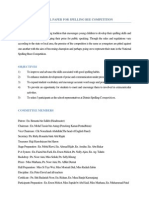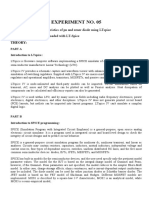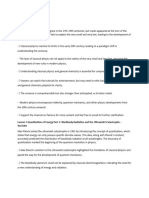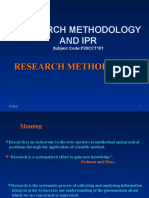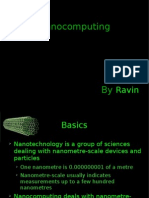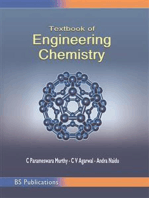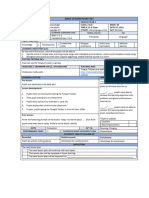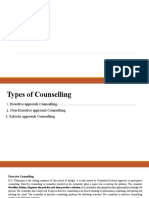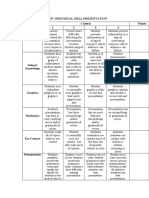ECE5029 Testing Syllabus
ECE5029 Testing Syllabus
Uploaded by
geethasri82Copyright:
Available Formats
ECE5029 Testing Syllabus
ECE5029 Testing Syllabus
Uploaded by
geethasri82Original Description:
Original Title
Copyright
Available Formats
Share this document
Did you find this document useful?
Is this content inappropriate?
Copyright:
Available Formats
ECE5029 Testing Syllabus
ECE5029 Testing Syllabus
Uploaded by
geethasri82Copyright:
Available Formats
Course Code Course Title L T P J C
ECE5029 VLSI TESTING AND TESTABILITY 3 0 0 0 3
Pre-requisite Nil
Course Objectives:
1. Model and simulate different types of faults in digital circuits at the gate level.
2. Establish equivalence and dominance relationships of faults in a circuit.
3. Critique and compare automatic test pattern generation algorithms with respect to search
space, speed, fault coverage and other criteria.
4. Handle design complexity, ensure reliable operation, and achieve short time-to-market
using various testing methodologies.
Expected Course Outcomes:
After completion of the course students will be able to:
1. Model different fault models.
2. Simulate faults and generate test patterns for combinational circuits.
3. Apply scan based testing.
4. Recognize the BIST techniques for improving testability.
5. Understand boundary scan based test architectures.
6. Analyse and apply the test vector compression techniques for memory reduction and fault
diagnosis.
Student Learning Outcomes (SLO): 1,2,17
1. Ability to apply mathematics and science in engineering applications.
2. Clear understanding of the subject related concepts and of contemporary issues.
17. Ability to use techniques, skills and modern engineering tools necessary for engineering
practice.
Module:1 Fault Modelling 6hours CO1
Importance of Testing - Testing during the VLSI Lifecycle - Challenges in the VLSI Testing: Test
Generation - Fault Models - Levels of Abstraction in VLSI Testing - Historical Review of VLSI
Test Technology - Functional Versus Structural Testing - Levels of Fault Models - Fault
Equivalence - Fault Dominance - Fault Collapsing - Check point Theorem - Delay Fault.
Module:2 Fault Simulation and Test Generation 7hours CO2
Fault Simulation: Serial, Parallel, Deductive, Concurrent - Combinational Test Generations
-ATPG for Combinational Circuits - D-Algorithm - Testability Analysis - SCOAP measures for
Combinational Circuits
Module:3 Scan based Testing 7hours CO3
Design for Testability Basics - Ad Hoc Approach - Structured Approach - Scan Cell Designs -
Scan Architectures - Scan Design Rules - Scan Design Flow – Special Purpose Scan Designs -
RTL Design for Testability.
Module:4 Built-in Self-Test 7hours CO4
BIST Design Rules - Test Pattern Generation - Exhaustive Testing - Pseudo-Random Testing -
Pseudo-Exhaustive Testing - Delay Fault Testing - Output Response Analysis - Logic BIST
Architectures - BIST Architectures for Circuits with and without Scan Chains
Module:5 Boundary scan and Core based Testing 5hours CO5
Digital Boundary Scan (IEEE Std. 1149.1): Test Architecture and Operations - On-Chip Test
Support with Boundary Scan - Board and System-Level Boundary-Scan Control Architectures.
Module:6 Test Compression and Compaction 6hours CO6
Test Stimulus Compression: Code-Based Schemes, Linear-Decompression-Based Schemes - Test
Response Compaction.
Module:7 Fault Diagnosis 5hours CO6
Dictionary Based and Adaptive fault diagnosis.
Module:8 Contemporary issues: 2hours
Total Lecture hours: 45hours
Text Book(s)
1. Z.Navabi, Digital System Test and Testable Design, Springer, 2011.
1. Laung-Terng Wang, Cheng-Wen Wu, and Xiaoqing Wen, VLSI Test Principles and
Architectures, The Morgan Kaufmann, 2013.
Mode of Evaluation:Continuous Assessment Test –I (CAT-I) , Continuous Assessment Test –II
(CAT-II), Seminar / Challenging Assignments / Completion of MOOC / Innovative ideas leading
to solutions for industrial problems, Final Assessment Test (FAT).
Approved by Academic Council No. 40
CO – SLO mapping
Module CO SLO
1 CO_01 2
2 CO_02 17
3 CO_03 1
4 CO_04 2
5 CO_05 17
6 CO_06 17
7 CO_06 2
You might also like
- Proposal Paper For Spelling Bee CompetitionDocument20 pagesProposal Paper For Spelling Bee CompetitionJiannifen Luwee95% (19)
- Business Analytics For Decision Making Mid Term Exam DR Mahmoud BeshrDocument7 pagesBusiness Analytics For Decision Making Mid Term Exam DR Mahmoud BeshrMohamed AhmedNo ratings yet
- Curriculum Theory and PracticeDocument16 pagesCurriculum Theory and PracticeJonathan Acuña100% (1)
- VLSI - T&T - ECT624 - Course File - MNIT - 06082019 PDFDocument8 pagesVLSI - T&T - ECT624 - Course File - MNIT - 06082019 PDFHARSHIT GARGNo ratings yet
- Ece5029 Vlsi-Testing-And-Testability TH 1.1 47 Ece5029Document2 pagesEce5029 Vlsi-Testing-And-Testability TH 1.1 47 Ece5029Chandan MalleshNo ratings yet
- VLSI Testing & TestabilityDocument1 pageVLSI Testing & TestabilityDr. Lokesh Kumar BramhaneNo ratings yet
- SyllabusDocument7 pagesSyllabusAlexaa ANo ratings yet
- Mid Rm&ipr Unit-1,2 Imp Q&aDocument12 pagesMid Rm&ipr Unit-1,2 Imp Q&aN MadhuNo ratings yet
- Quantum MechanicsDocument16 pagesQuantum MechanicsrodolfoccrNo ratings yet
- Journal Finding Tools & Research MetricsDocument40 pagesJournal Finding Tools & Research MetricsjyothsnadevikuchipudiNo ratings yet
- 1st MODULE RM&IPRDocument27 pages1st MODULE RM&IPRfakemefakerulesNo ratings yet
- Ch 1 Introduction to transport phenomenaDocument21 pagesCh 1 Introduction to transport phenomenaYeabsira AbinetNo ratings yet
- Sagnac Interferometer: Theory & Background: 5.1 Introduction To Sagnac InterferometersDocument15 pagesSagnac Interferometer: Theory & Background: 5.1 Introduction To Sagnac InterferometersTrần QuangNo ratings yet
- Experiment No. 05: Simulate I-V Characteristics of PN and Zener Diode Using LtspiceDocument10 pagesExperiment No. 05: Simulate I-V Characteristics of PN and Zener Diode Using LtspicesindhuNo ratings yet
- ELECTRIC COMPARATORS: PRINCIPLES - Linear Variable Differential Transformer (LVDT) Electrical ComparatorsDocument2 pagesELECTRIC COMPARATORS: PRINCIPLES - Linear Variable Differential Transformer (LVDT) Electrical ComparatorsvaibhavmnNo ratings yet
- Vlsi Design Test and TestabilityDocument17 pagesVlsi Design Test and TestabilitySuravarapu ArunaNo ratings yet
- Testing&Testabilty Course PlanDocument5 pagesTesting&Testabilty Course PlanLava Kumar BNo ratings yet
- NANOTECHNOLOGYDocument28 pagesNANOTECHNOLOGY159Trupt VaghaniNo ratings yet
- Linear Variable Differential Transformer LVDTDocument5 pagesLinear Variable Differential Transformer LVDTPoonam YadavNo ratings yet
- Unit-Iv Patent Rights: Scope of Intellectual Property RightsDocument10 pagesUnit-Iv Patent Rights: Scope of Intellectual Property RightsTHIYAGARAJAN NNo ratings yet
- RM&IPR Notes - Unit 3Document36 pagesRM&IPR Notes - Unit 3Sai PrasadNo ratings yet
- Electrical Engineering - Caltech CatalogDocument9 pagesElectrical Engineering - Caltech CatalogAnmol GuptaNo ratings yet
- Module-4 IPRDocument67 pagesModule-4 IPRMadhav BNo ratings yet
- Anglais ExDocument4 pagesAnglais Exzein zeidNo ratings yet
- RMC0001 - Research Publications & Ethics SyllabusDocument3 pagesRMC0001 - Research Publications & Ethics Syllabusgopalakrishnan rNo ratings yet
- MIT2 57S12 Lec Notes 2004 PDFDocument177 pagesMIT2 57S12 Lec Notes 2004 PDFGerman ToledoNo ratings yet
- Week8 InterferometersDocument84 pagesWeek8 InterferometersArijit PanigrahyNo ratings yet
- Experiment No.02 To Observe The Characteristics of A Half Wave RectifierDocument4 pagesExperiment No.02 To Observe The Characteristics of A Half Wave RectifierWaqas MughalNo ratings yet
- RM IprDocument98 pagesRM IprnikhilghnikiNo ratings yet
- Testing in VlsiDocument32 pagesTesting in VlsiUnknown KnownNo ratings yet
- Experimental Physics - II - Unit 2 - Week 0 Assignment 0Document10 pagesExperimental Physics - II - Unit 2 - Week 0 Assignment 0adimegha100% (1)
- CH 3MECHATRONICS Signal ConditioningDocument27 pagesCH 3MECHATRONICS Signal ConditioningMilion dugumaNo ratings yet
- NanotechnologyDocument22 pagesNanotechnologycse.20bcsa65No ratings yet
- Nanotechnology and MicroelectronicsDocument14 pagesNanotechnology and MicroelectronicsAbdulmujib Lucero AhmadNo ratings yet
- Type1: Temperature Type2: IR Sensors Type3: UV Sensors Type4: Touch Sensor Type5: Proximity Sensor Advanced Sensor TechnologyDocument5 pagesType1: Temperature Type2: IR Sensors Type3: UV Sensors Type4: Touch Sensor Type5: Proximity Sensor Advanced Sensor TechnologyRajeshNo ratings yet
- Nano ComputingDocument12 pagesNano Computingsdtechman100% (1)
- Strain Gauges: By: Pinank ShahDocument31 pagesStrain Gauges: By: Pinank ShahAnas EkramNo ratings yet
- RMIPRDocument85 pagesRMIPRWilliam Jaya PrakashNo ratings yet
- Report On RF MEMS SwitchesDocument23 pagesReport On RF MEMS SwitchesSarjak Shah100% (2)
- Modern Physics NotesDocument5 pagesModern Physics NotesMaria Julina SorianoNo ratings yet
- VLSI Testing and Testability: Fault SimulationDocument12 pagesVLSI Testing and Testability: Fault Simulationsanjay_nittNo ratings yet
- Chap4 Lect04 Defects FaultsDocument18 pagesChap4 Lect04 Defects Faultsdigi1988No ratings yet
- Dr. AK - RM&IPR - UNIT-1 - NotesDocument10 pagesDr. AK - RM&IPR - UNIT-1 - NotesBilal uddinNo ratings yet
- 22mba23 Rm&Ipr FullDocument227 pages22mba23 Rm&Ipr FullNaveen S BasandiNo ratings yet
- Strain Gauge Theory of Strain GaugeDocument22 pagesStrain Gauge Theory of Strain GaugeBenjamin EstrelladoNo ratings yet
- RM and IPR Unit IDocument79 pagesRM and IPR Unit Ip.arunagiriNo ratings yet
- Introduction To NanotechnologyDocument10 pagesIntroduction To Nanotechnologyrkindusty.solutionNo ratings yet
- Piezoelectric EnergyDocument10 pagesPiezoelectric EnergyDNes RAj PAlikhelNo ratings yet
- Physics Projects For 2nd YrDocument2 pagesPhysics Projects For 2nd Yramit davaNo ratings yet
- PHD RMPE RES 804 SOL and HumanitiesDocument4 pagesPHD RMPE RES 804 SOL and HumanitiesJahnavi HSNo ratings yet
- Nano ComputingDocument9 pagesNano ComputingRavinNo ratings yet
- Sampada A Deshpande PDFDocument2 pagesSampada A Deshpande PDFArul Das DivakaranNo ratings yet
- Strain Gauge 1Document26 pagesStrain Gauge 1ULFAT HUSSAINNo ratings yet
- Test Generation For Combination & Sequential CircuitsDocument48 pagesTest Generation For Combination & Sequential CircuitsGuru VelmathiNo ratings yet
- Displacement MeasurementDocument90 pagesDisplacement Measurementsarma gvssNo ratings yet
- Basics of Quantum MechanicsDocument43 pagesBasics of Quantum MechanicsIvan MishelNo ratings yet
- Learn With Liz: Author MetricsDocument12 pagesLearn With Liz: Author MetricsElizabeth JoyNo ratings yet
- Introduction To NanomaterialsDocument108 pagesIntroduction To Nanomaterialsclean420No ratings yet
- Physics ProjectDocument2 pagesPhysics ProjectUdithyaNo ratings yet
- Binary Counter ProjectDocument8 pagesBinary Counter ProjectCharmae BonggoNo ratings yet
- Winsem2019-20 Ece3002 Eth Vl2019205005284 Reference Material Ece3002 Vlsi SyllabusDocument3 pagesWinsem2019-20 Ece3002 Eth Vl2019205005284 Reference Material Ece3002 Vlsi SyllabusAYUSH GURTUNo ratings yet
- метод ЧТ 20 без ответDocument10 pagesметод ЧТ 20 без ответАйдай ЖоробекNo ratings yet
- Handling Thoughts and Emotions: Swami Bhoomananda TirthaDocument2 pagesHandling Thoughts and Emotions: Swami Bhoomananda TirthaDeepuNo ratings yet
- NLP AkashDocument4 pagesNLP AkashNikhil TiwariNo ratings yet
- Department of Education: English 10Document4 pagesDepartment of Education: English 10Khent SolomonNo ratings yet
- PDF Perdev Module 2 Final 2020Document11 pagesPDF Perdev Module 2 Final 2020MinMiiin ValloNo ratings yet
- Dbms Gis DesignDocument5 pagesDbms Gis Designbhuvi2312No ratings yet
- Advanced Grammar - Noun ClausesDocument4 pagesAdvanced Grammar - Noun ClausesDori Pérez CruzNo ratings yet
- Kodu - Programming A Rover - Lesson PDFDocument37 pagesKodu - Programming A Rover - Lesson PDFrenancostaalencarNo ratings yet
- Download Psychology Daniel L. Schacter ebook All Chapters PDFDocument40 pagesDownload Psychology Daniel L. Schacter ebook All Chapters PDFhilelharvioNo ratings yet
- Compilation Prof EdDocument108 pagesCompilation Prof EdRudy Ric D. TrabelNo ratings yet
- RPH 38Document11 pagesRPH 38Mary AnnNo ratings yet
- Psychoeducational Evaluation ReportDocument4 pagesPsychoeducational Evaluation Reportapi-270517475No ratings yet
- Week 5 Css 7 Summative TestDocument2 pagesWeek 5 Css 7 Summative TestAhron Lee SanchoNo ratings yet
- Chapter Four L & C.thinkingDocument47 pagesChapter Four L & C.thinkingEyu BekeleNo ratings yet
- EIPCRFv4.2 JRCD. No ScoreDocument17 pagesEIPCRFv4.2 JRCD. No ScoreJenny Rose Cabural DizonNo ratings yet
- Types of CounsellingDocument6 pagesTypes of Counsellingme tanzeemNo ratings yet
- The History of Social PsychologyDocument3 pagesThe History of Social Psychologydosti24No ratings yet
- Tests - PsychLabDocument22 pagesTests - PsychLabMelai Delos Reyes Celes0% (1)
- Flipped ClassroomDocument23 pagesFlipped ClassroomjcsynkNo ratings yet
- Business Strategy Formulation Theory, Process, and The Intellectual RevolutionDocument224 pagesBusiness Strategy Formulation Theory, Process, and The Intellectual RevolutionKhaja Abdul Sattar100% (1)
- Basics of Technical CommunicationDocument9 pagesBasics of Technical CommunicationHamid HaqaniNo ratings yet
- Panduan S1 2015-2016Document67 pagesPanduan S1 2015-2016AngrysAngelinaNo ratings yet
- Verb PhraseDocument6 pagesVerb PhraseJohn Ian Salido100% (1)
- Eastern Mindoro College, Inc.: Week: 1-3 Hours: 9 Lesson Title: Introduction To LiteratureDocument7 pagesEastern Mindoro College, Inc.: Week: 1-3 Hours: 9 Lesson Title: Introduction To LiteraturePrecilla Zoleta SosaNo ratings yet
- Classroom Observation 1 (SY 2022-2023)Document3 pagesClassroom Observation 1 (SY 2022-2023)James Celmar100% (1)
- RUBRICS of Grading For Oral Prep & Written OutputDocument2 pagesRUBRICS of Grading For Oral Prep & Written OutputFatzie MendozaNo ratings yet
- Clasa A VIII-a B - " Third Conditional Clause" - Lecție de Achiziție de Noi CunoștințeDocument5 pagesClasa A VIII-a B - " Third Conditional Clause" - Lecție de Achiziție de Noi CunoștințeMadalinaNo ratings yet
